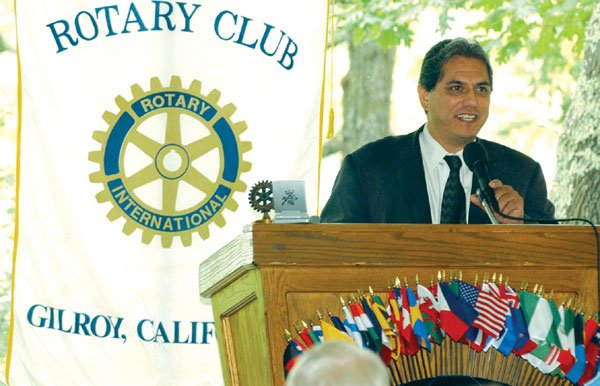Gilroy
– Gilroy Unified School District Superintendent Edwin Diaz
called for increased community involvement in what he considers to
be the district’s top priorities: Accountability and the new
Christopher High School.
Gilroy – Gilroy Unified School District Superintendent Edwin Diaz called for increased community involvement in what he considers to be the district’s top priorities: Accountability and the new Christopher High School.
Diaz was greeted by warm applause from about 100 members of the Gilroy Rotary Club Tuesday at the Elks Lodge. His 30-minute address highlighted the importance of community involvement in the building of the new Christopher High School and in the Accountability Task Force.
“Basically every school district in California is trying to improve their educational experience for kids,” he said. “But very few reach breakthrough levels.”
According to Diaz, the formation of Gilroy’s ATF is an essential element in improving the district’s performance – and an area where many districts fall short.
“It’s a step, I think, very few districts in California have taken,” he said.
Gilroy’s ATF was formed last fall to help define the district’s goals and ensure implementation of the accountability plan. The ATF is comprised of 20 members, including GUSD principals and teachers, parents and business professionals, who review student performance data throughout the year and report the findings to the public.
“The accountability plan requires us to look at the results on an annual basis – to look at that data, share that data, and act on it,” he said.
Diaz, dressed sharply in a charcoal gray suit and sporting a black and green tie, spoke for about 10 minutes on accountability before moving on to discuss the building plans for Gilroy’s second high school.
And so far, there aren’t any.
Christopher High School will someday be located between Santa Teresa Boulevard and Day Road, however, the land has not yet been purchased, nor is there an architectural design in place.
According to Diaz, the district is still performing a cost analysis to determine whether a second-story design would be better. By building higher – less land is needed.
Gilroy High School was built to accommodate 1,800 students. Currently, more than 2,400 students are enrolled. According to enrollment projections, by 2009 (when Christopher High School is slated to open) GHS will house almost 2,700 students.
For the next 16 months, Christopher High School is in the pre-design phase, during which community involvement is most needed, Diaz said.
“Christopher High School could possibly look a lot different from Gilroy High School,” he explained. “The issue that I am really concerned about is the impact on the community and the identity that we have.”
Because the district cannot afford to build two identical high schools, there will be a difference in the facilities offered at each school.
Cost is one reason the district has decided to upgrade GHS’ football field – so they don’t need to build a second stadium at Christopher High School. Instead both teams and the community can use the stadium at GHS, Diaz said.
But could this be the start of a new rivalry?
Just this month, Live Oak High School in Morgan Hill was placed on probation through the 2005-06 school year because of a recruiting violation. The head football coach broke conference rules by deliberately attempting to influence future high school students to attend Live Oak over Sobrato High School – Morgan Hill’s recently opened high school.
But rivalries do not just remain on the playing field.
The district must also decide whether or not to concentrate the vocational education program at one school.
In order to have a quality program, you have to maximize the materials, Diaz said. The technology in vocational programs is expensive and needs to be kept updated. Otherwise, students are not benefiting from the program.
While the academic programs should be equivalent between both Gilroy high schools, who has which facilities, who has which programs can all impact the community’s sense of identity, Diaz said.
This is why he is hoping for community input during the course of the year.
“There’s very few people who have the answers related to high school reform,” he said. “This is an opportunity to not only build a new high school, but to redesign the current program at GHS.”
Edwin Diaz on Edline:
“It’s working well for the teachers and parents who are actually using it . . . I think the potential is great, but right now only 28 percent of staff is using it and a very small percentage of parents.”
On accountability plan:
“It will for sure include one comprehensive report of all of those (39 data) indicators in December. That will be presented by the Accountability Task Force to the community.”
On parent involvement:
“Usually the parents whose children are doing well are the most involved. We’re trying to create a big impact at the primary levels – where its parents first contact with the district.”
On classroom mobility:
“Our mobility rate is between 28 and 30 percent. It’s high, but not as high as some districts. … We have a number of migrant, homeless, and poor families which accounts for a lot of the moving.”















